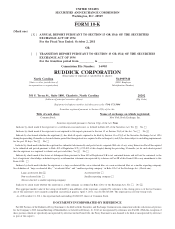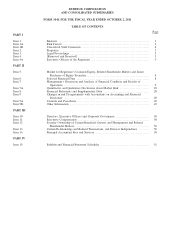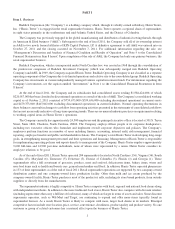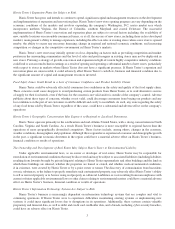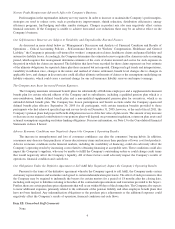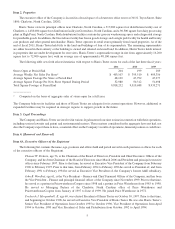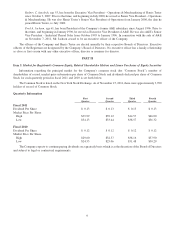Harris Teeter 2011 Annual Report Download - page 13
Download and view the complete annual report
Please find page 13 of the 2011 Harris Teeter annual report below. You can navigate through the pages in the report by either clicking on the pages listed below, or by using the keyword search tool below to find specific information within the annual report.Item 7. Management’s Discussion and Analysis of Financial Condition and Results of Operations
This Management’s Discussion and Analysis of Financial Condition and Results of Operations includes forward-looking
statements. We have based these forward-looking statements on our current plans, expectations and beliefs about future events.
In light of the risks, uncertainties and assumptions discussed under Item 1A “Risk Factors” of this Annual Report on Form 10-K
and other factors discussed in this section, there are risks that our actual experience will differ materially from the expectations
and beliefs reflected in the forward-looking statements in this section and throughout this report. For more information regarding
what constitutes a forward-looking statement, please refer to “Risk Factors” in Item 1A hereof.
Overview
The Company operates one primary business segment, retail grocery (including related real estate and store development
activities) – through its wholly-owned subsidiary Harris Teeter. Harris Teeter is a regional supermarket chain operating primarily
in the southeastern and mid-Atlantic United States, and the District of Columbia. The Company evaluates the performance of
Harris Teeter utilizing various measures which are based on operating profit.
Historically, the Company also engaged in industrial sewing thread (textile primarily), including embroidery thread and
technical textiles, through its A&E business. Subsequent to the end of fiscal 2011, the Company sold all of its ownership interest
in A&E to two newly formed affiliates of KPS Capital Partners, LP. A definitive agreement to sell A&E was entered into on
October 27, 2011 and the closing occurred on November 7, 2011. The sale price for A&E was $180 million in cash, subject
to adjustments for working capital and certain liabilities including underfunded pension liability and foreign debt. In connection
with the sale, the Company recorded a pre-tax loss on sale of discontinued operations of $48.8 million in the fourth quarter
of 2011. As a result of this disposition, the sales and operating results of A&E are categorized as discontinued operations in
the discussion that follows and in the financial statements included in Item 8 hereof for all periods presented. For additional
information regarding discontinued operations, see Note 5 to the Consolidated Financial Statements in Item 8 hereof.
The economic environment over the past few years has motivated changes in the consumption habits of the retail consumer
which continues to impact our financial results. Economic uncertainty, tumultuous market conditions and low levels of consumer
confidence have created changes in the type of products purchased by Harris Teeter customers and increased the competitive
environment in Harris Teeter’s primary markets. Harris Teeter competes with other traditional grocery retailers, as well as other
retail outlets including, but not limited to, discount retailers such as “neighborhood or supercenters” and “club and warehouse
stores,” specialty supermarkets and drug stores. Generally, Harris Teeter’s markets continue to experience new store opening
activity and increased feature pricing or everyday low prices by competitors. Harris Teeter utilizes information gathered from
various sources, including its Very Important Customer (“VIC”) loyalty card program, and works with suppliers to deliver
effective retail pricing and targeted promotional spending programs that drive customer traffic and create value for Harris Teeter
customers. In addition, Harris Teeter differentiates itself from its competitors with its product selection, assortment and variety,
and its focus on customer service.
Harris Teeter has continued with its planned new store development program and has opened seven new stores and closed
two stores for a net addition of five stores during fiscal 2011. During fiscal 2010, Harris Teeter opened 13 new stores and closed
three stores for a net addition of 10 stores, and during fiscal 2009, Harris Teeter opened 15 new stores and closed two stores
for a net addition of 13 stores. The reduction in new store growth activity was due to management’s decision to delay new store
openings, when possible, during the periods of economic uncertainty we have experienced in Harris Teeter’s markets. Much
of Harris Teeter’s new store growth is focused on expanding its Washington, D.C. metro market area which incorporates northern
Virginia, the District of Columbia, southern Maryland and coastal Delaware. During the first quarter of fiscal 2011, Harris Teeter
acquired 350,000 square feet of additional distribution capacity that is contiguous to its existing distribution facility in
Greensboro, North Carolina. This represents an approximate 22% increase in the square footage of Harris Teeter’s existing
distribution facilities and was acquired to meet the company’s continued growth.
Results of Operations
Discontinued Operations
On November 7, 2011, the Company completed the sale of all of its ownership interest in its thread manufacturing business,
A&E. In connection with the sale of A&E, the Company recorded a pre-tax loss on sale of discontinued operations of $48.8
million in the fourth quarter of fiscal 2011. In addition,A&E’s historical results of operations have been classified as discontinued
operations for all periods presented.
9


